 Supporting diverse working styles
Supporting diverse working styles

Ensuring a good work-life balance
Advantest supports its employees in their pursuit of a good work-life balance based on Japan's Act on Advancement of Measures to Support Raising Next-Generation Children. We believe that the work-life balance concept will help make the company a comfortable place to work for all employees and ultimately contribute to increasing our corporate value. Therefore, we are taking measures to reduce overtime hours and create a work environment that facilitates a good work-life balance, allowing our employees to actively pursue outside interests and become well-rounded individuals.
Arranging a balanced support system for work and family
Advantest has implemented a variety of measures so that all employees, while fully playing to their ability, can balance work and family (also partially includes non-regular employees).
Pregnant employees can receive 100% compensation during pregnancy visits and pregnancy complications leave (introduced in April 2007) and employees that work while caring for children can take up to about 2 years childcare leave (introduced in April 2001). Also, employees with children up to the 3rd grade can choose short working hours.
It should be noted that re-employment following childcare leave was 94.4% in fiscal 2014. We plan to complete standardized facilities for work-life balance, publicize the system and continue to make improvements while confirming the status of usage.
Number of staff using childcare leave
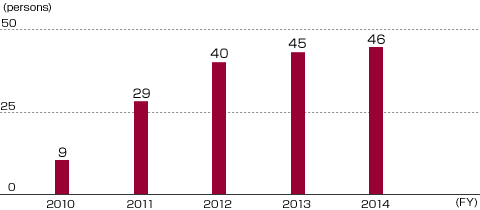
* Scope: Advantest only
Number of employees using childcare short working hours
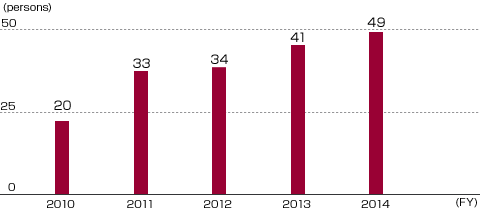
* Scope: Advantest only
Number of employees using caregiving and nursing leave
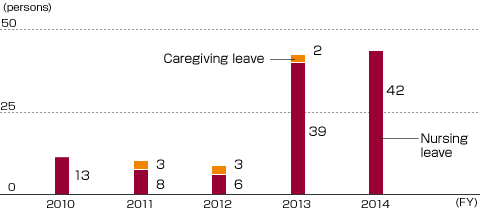
* Scope: Advantest only

The Work-Life Balance Support
Guide on the internet
In 2007, we placed the Work-Life Balance Support Guide on the intranet to gain broader recognition of the various programs Advantest provides and encourage take-up. The guide also offers information on related services provided by local governments.
Reducing overtime hours
The most important issue regarding work-life balance is the reduction of overtime hours. To address this issue, we set the goals specified below and then focused on increasing operational efficiency, encouraging a change in employee mindsets, and making the most of available work arrangements such as flextime and shift work.
Our overtime reduction goals are:
1. Number of employees with monthly overtime of 80 hours or more: zero
2. Average monthly overtime hours: 9 or fewer (excluding discretionary labor)
We have also made start and finish times more flexible and introduced half-day leave slots to make it easier for employees with working spouses to adjust their work schedules so that they can better share household chores and responsibilities.
In fiscal 2014, the Company reduced maximum working hours under Japan's "Article 36 Agreement”, pledged to deal seriously with overtime reduction for all employees, and reminded supervisors of their responsibility to ensure that employees do not work excessive hours. Since fiscal 2011, we have made announcements via the public address system urging employees to leave the office on time on Wednesday, and we have been notifying the immediate supervisors of employees found to be working excessive overtime (15 or more hours of overtime already clocked by the 15th of the month, or 70 or more hours by the 20th and 25th of the month, or three days of holiday worked already by the 20th and 25th). In the second half of fiscal 2014, we began issuing notices to supervisors when employees clocked four or more hours of overtime by the 10th of the month, or seven or more hours by the 20th of the month, in an effort to further reduce overtime hours.
Although we were able to achieve our goal of fewer than 9 average monthly overtime hours from the second half of fiscal 2014 as a result of these initiatives, we were not able to achieve our goal of zero employees working 80 or more monthly overtime hours. The reason was that we had to deal with unexpected problems and meet short lead times.
For fiscal 2014 the overtime hours per person was 11.8 hours, but for the second half we achieved the level of less than 9 hours.
Average overtime hours per person
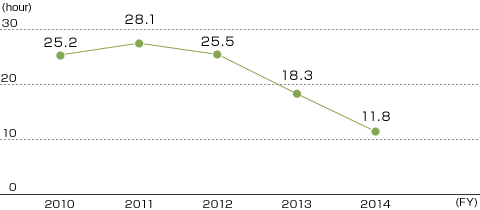
* Scope: Advantest only
Number of employees taking accumulated holiday
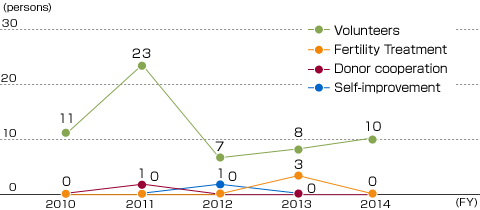
* Scope: Advantest only



